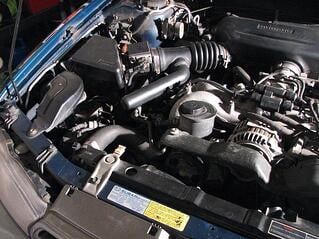1962 Ford 302 Runs Rough Then Smooth Then Rough Again
In this series, Bell's resident chief mechanic James Dunst discusses the most common mechanical problems that he gets asked well-nigh. He discusses the causes, what (if anything) tin exist washed near them, and any further questions that a mechanic would probably enquire in seeking to properly diagnose a set up such a problem. A properly-operating engine should run smoothly and without excess noise. If your engine starts operating in a way that gives you the perception of "running rough", it is likely due to a handful of common causes. A mechanic would investigate these common causes first in order to rule out a elementary explanation for the engine's unsatisfactory operation. The mutual causes for rough running in an engine are: Earlier looking at each of these, let'southward take a moment to consider how the mechanic should diagnose the cause of the problem. When diagnosing an engine with a rough idle, there are certain things that must exist done prior to replacing parts or performing service. If yous accept a 1981 or newer vehicle, it will almost likely have an engine direction computer. The computer monitors the functions of a number of engine compartment components. When a problem develops in a organization that is monitored past the computer, codes which relate to the particular system will be prepare and retained in the computer'southward memory. When this happens, the check engine light on the dash will illuminate. If the low-cal stays on continuously this is called a difficult fault and is the easiest problem to observe because the problem is there right now. If the calorie-free comes on and goes out, the fault is intermittent, meaning the trouble was at that place momentarily but has cleared up. Both these conditions will gear up codes that are retained by the computer for later investigation. In most vehicles these diagnostic codes will remain in memory for fifty engine warmup cycles. If the problem does not reoccur, the codes will exist erased by the computer. Steer clear of a mechanic or shop that replaces parts without doing the proper diagnostics first. Checking for figurer codes first is important because it may lead yous to the rough running problem. And this is what y'all should await a competent mechanic to do if you present them with this kind of problem. High mileage vehicles with over 100,000 miles are the almost likely to start having engine miss issues (information technology can exist less in some vehicles), and it is advisable to have a compression examination performed to rule this out. If you have depression pinch on one or more cylinders, this could be indicative of a more serious status that would demand to be stock-still immediately. The normal process for a compression test is to remove all the spark plugs, insert a compression estimate into the spark plug hole, and then turning the engine over about iii times. Record the reading and do this for all the cylinders. If in that location is more than a 20% difference in any of the readings, a farther test would be required to make up one's mind if the variance problem is due to an issue with the piston rings or the valves. How can a mechanic (or y'all) tell which is the cause? The next footstep would be to squirt a small corporeality of oil effectually in the cylinder that had the low compression reading, and echo the compression exam on that cylinder. If the compression rises from the previous test reading, the trouble is due to the piston rings. The oil helps to better the seal, thus compensating for the pinch that was lost from worn piston rings in the start reading. That's why the pinch would be higher in the second test. If no increase is seen in the compression the second fourth dimension effectually, the trouble is most likely a burned valve. And so now you have a better idea of which kind of mechanical fault is contributing to the trouble. If either problem is found, disassembly of the engine would be required to repair the problem. Special attention should exist paid when removing the valve covers to make sure the valves are all moving the same amount of downward travel. Some engines accept problems where the camshaft lobes will clothing downwardly and prevent the valve from opening which tin can besides exist the cause of the misfire. At this point, a good mechanic volition be able to take the problem on and fix information technology. It may not be a cheap fix, nonetheless. Almost engine compartments accept a maze of vacuum hoses which can wear out from use at any time. What we mean is they go breakable and difficult over time. It'southward just i of those things that happens during the life of the engine. If whatever of these hoses spring a leak, a lean air/fuel condition volition result, causing a rough idle from the resulting engine misfire. The misfire could be in ane cylinder or in multiple cylinders, depending on the size or location of the leak. Vacuum leaks can also be caused past leaking intake manifold gaskets, vacuum brake boosters or vacuum supply tanks. How can you tell if the trouble is acquired past a vacuum leak? When driving a vehicle with a small vacuum leak, y'all will discover that everything feels normal at higher speed or RPM, but runs rough when the engine is at an idle. The engine could seem to rev up and downwardly on its ain at idle, merely it's more likely that it will simply rev upward abnormally and stay there at idle. Either manner, that'southward a big indicator of a vacuum leak. A mechanic will seek to get confirmation of a vacuum leak past looking for a lean lawmaking set in the engine reckoner. This makes sense because a leak in a vacuum hose means more than oxygen is entering the system than is needed. That results in a lean reading – not plenty fuel, too much air. The engine tin't run properly if the air/fuel mixture isn't right. Once a mechanic has narrowed downwards the problem crusade to a vacuum leak, they will want to make up one's mind where the leak is located at. It would exist helpful if you can pinpoint it yourself. Who knows, y'all may exist able to set it at that point. When attempting to diagnose the source of the leak, the first affair you do is to listen for a hissing sound in the engine compartment. Many times it can be a simple thing like a vacuum hose that has become dislodged – in this case, all you demand to do is reinstall it. If y'all suspect the leak is caused by a component similar a vacuum brake booster or vacuum supply tank, yous tin can pinch off the hose to the suspected component with a pair of needle nose plyers. If the component tested is the problem, the idle will polish out. Lastly, if you suspect the intake manifold gaskets are leaking, you can take a product like WD40 and spray information technology along the border of the intake manifold while the engine is idling. If the gaskets are leaking, the idle volition polish out or change when spraying the WD40. If muddied fuel injectors are the crusade of the problem, y'all tin can expect more than simply a rough idle. Dingy fuel injectors are possibly the biggest contributor to poor gas mileage. If the injectors are restricted, the engine's lack of functioning volition be even more noticeable when accelerating the vehicle, which causes a higher fuel demand. Diagnosing this condition is all-time done by a repair store with an exhaust gas analyzer. Restricted injectors will cause loftier carbon monoxide and hydrocarbon readings. This is because anything that interferes with an platonic fuel spray causes an incomplete burn of the fuel, and this will generate excessive carbon monoxide in the exhaust. We know this because complete combustion gives water and carbon dioxide as byproducts. Incomplete or improper combustion ways the fuel isn't burning completely and you'll go both elevated carbon monoxide and higher hydrocarbon readings equally a result. You lot get higher hydrocarbon readings from the exhaust because when an engine misses, raw fuel enters the frazzle organization and creates high hydrocarbon readings. Restricted injectors will cause both of these conditions. If dirty injectors are indeed the problem, a mechanic will employ an injectable cleaning concentrate to clear them out. This is a problem that really lends itself to prevention. Using an injector cleaner gas additive to preclude problems before they happen is the best way to keep this kind of problem from happening in the future. When we beginning talking almost carburetors, you know nosotros're thinking of both older vehicles with higher mileage and small engines. One of the indicators of a carburetor trouble is a considerable amount of blackness frazzle smoke when the engine is up to temperature. A properly-working carbureted system shouldn't produce volumes of black fume – this would be a sign that something is awry. The first thing to check is the choke to make sure it is fully open when the engine is warmed upward. If the choke is open, the likely problem shifts to an internal issue requiring a carburetor rebuild. A damaged float might exist an case of this. In many cases, the floats in the carburetors have been damaged from the ethanol in today'south fuel. Another expanse of business organisation is the throttle shaft in the base of operations of the carburetor. Over time the throttle shaft volition clothing the carburetor base of operations housing at each end of the shaft, causing a vacuum leak. You lot can check this in the same way I explained earlier in this article by using WD40. Simply spray it at both ends of the throttle shaft and meet if the idle straightens out or changes. Should this be the problem, the repair for this condition is a carburetor replacement. A word of warning when purchasing rebuilt carburetors. Before you lot buy, bank check for wear or play in the throttle shaft. Some of these rebuilt carburetors have just as many miles on them as yours does. Excessive play in this surface area ways you lot want to avoid that detail slice. The EGR Valve (Exhaust Gas Recirculation Valve) is an emission control device that allows frazzle gas to enter the intake manifold. These started becoming mutual on both gas and diesel engines one-time in the 1970s. They function to reduce harmful emissions from the engine. There are three times in a engine's operating bicycle than an EGR valve is never supposed to operate: i) at engine idle, 2) at broad open throttle or 3) when the engine is cold. In all three areas, it would have a negative effect on the way the engine runs, especially when the engine is idling. With respect to our problem of rough running, an EGR valve can exist a crusade if it becomes fouled with carbon. This causes it to stick open, causing a crude idle or engine stall. As explained before, in many cases the computer may prepare codes which can lead y'all to the EGR valve every bit the prsoblem. Confirming a stuck EGR valve can be every bit simple at giving it a lite tap on the side of the valve, which may complimentary it from its stuck-open position. In most cases, dirty EGR valves tin can exist cleaned which usually resolves the problem. If cleaning is non an option, a replacement valve would exist required. Again, this is a elementary problem that's inexpensive to fix – most people tin replace an EGR valve themselves. So if your engine's unsatisfactory performance is due to a dingy EGR valve, you're going to get off cheap. If you have a rough idle that is acquired past either the spark plugs, spark plug wires or ignition roll, yous will also feel it when accelerating. If these parts are bad enough to cause a miss at idle, it will continue to miss while driving. If either 1 of these items is starting to go bad but not missing at idle, a jerking sensation will usually exist felt when accelerating the vehicle nether a load. Then paying attention to how the vehicle feels at different point of driving is what will help diagnose this. It is important to note that anything that causes a miss in a vehicle with a catalytic converter needs to be repaired immediately. If you accept a cylinder missing, it will exist sending raw fuel dorsum into the exhaust system. Unburned gasoline going into a hot catalytic converter is a perfect recipe for a fire. This status volition cause the converter to glow red and may cause a fire hazard if parked over combustible materials. Many grass fires have been started in this manner. Fifty-fifty if you escape a fire, continued operation of a vehicle with this condition can damage or destroy the catalytic converter requiring replacement. And that can be pretty expensive. Drivers of straight-injected gasoline engines have been complaining nearly a crude idle and a check engine light that has been illuminating on the nuance. These engines are experiencing a trouble with carbon build-up on the peak side of the intake valves. Excessive deposits in this location tin disrupt the air fuel period, causing an engine to misfire. These engines inject the fuel directly into the combustion bedroom, eliminating the power for the detergents in the gasoline to wet the top side of the valves and keep them free of carbon. This carbon build up comes from the PCV gases in the crankcase and from EGR exhaust gases inbound the cylinder through the intake valve. Most of the vehicles experiencing this problem have more 30,000 miles but some have been seen with less. The bank check engine lite comes on because the engine is missing at idle, causing a P300 random misfire code to be ready in the computer. In that location are only two options when this problem occurs. The intake manifold would need to be removed and the valves blasted with a walnut shell media. The second treatment would be to spray intake valve cleaner into the engine air intake while running engine at a high RPM. Merely fifty-fifty if you try either of these solutions success depends on how long the carbon has been on the valve surface. There is a indicate where carbon has been in that location so long, it cannot be chemically removed because it has polymerized and turned into varnish that is impervious to chemicals. And so blasting the carbon off would be the only workable solution.  Through the Contact Us forms on the Bell web site, nosotros become all kinds of inquiries near fuel problems and engines from the full general public. Some of them describe mechanical problems that people are having – bug that, while common across the manufacture, require some further investigation before the correct communication tin can be given.
Through the Contact Us forms on the Bell web site, nosotros become all kinds of inquiries near fuel problems and engines from the full general public. Some of them describe mechanical problems that people are having – bug that, while common across the manufacture, require some further investigation before the correct communication tin can be given.
The Common Problem: Rough Running Engine
Checking the computer for diagnostic codes
Mechanical reasons for a crude idle or engine miss
Rough idle caused by a vacuum leak
Rough idle caused by dirty fuel injectors
Rough idle acquired by carburetor issues

Rough idle caused by the EGR valve
Rough idle caused by spark plugs, spark plug wires or ignition roll problems
Catalytic convertors
Crude idle in vehicles with Gasoline Direct- Injected engines
Yous might find these other posts helpful:

This postal service was published on April 21, 2015 and was updated on Nov 21, 2018.
Source: https://www.bellperformance.com/blog/rough-running-engine
0 Response to "1962 Ford 302 Runs Rough Then Smooth Then Rough Again"
Post a Comment